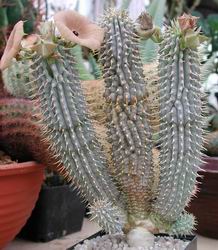Hoodia juttae
DINTER
(juttae:
refers to Jutta Dinter, Kurt Dinter's wife)
Hoodia juttae
Dinter, Neue
Pfl. Südw.-Afr.: 34.
1914 et in
Sukkulentenforschung 2: 91 (1928)
|
|
|
|
published in "Cacti and other Succulents" (KUAS, German original title "Kakteen und andere Sukkulenten) ??? 54 (1) 2003: III-IV |
|
|
Ill. 1: Flowers opening the same time. |
|
by Ulrich Tränkle and Friederike Hübner 1. First DescriptionHoodia juttae Dinter, Neue Pfl. Südw.-Afr.: 34. 1914 et in Sukkulentenforschung 2: 91 (1928) 2. DescriptionPlant: opulently branching shrub, up to 30 by 50 cm, predominantly branching out from the base, stems pale grey-green, erect, 3 to 5 cm wide. Rows: tubercles set up in rows of 15-17, each ending in a pale grey-green 8 to 11 cm long spine. Flowers: appearing in groups of 1 to 4 in the upper part of the stem, opening up successively. Pedicel: between 10 and 30 mm long and 2.5 to 4 mm wide. Sepals: between 3 and 5 mm long, base ± 2 mm wide, acuminate and hairless. |
|
|
Ill. 2: Habitus.
Ill. 3: Close-up of the Corona. |
|
Corolla: between 2 and 5.5 cm in diameter, glabrous and smooth on both sides, flat to slightly saucer-shaped in form, wide, 5-lobed with 1 mm saucer-shaped tubular corolla, thickening on the outside. The corolla is pressed onto the corona lobes on the outside of the tube. The lobes are broadly oval, acuminate, 4-8 mm long and 15-25 mm wide at the base. On the outside of pale yellow-brown colour, on the inside varying from pale yellow-brown to flesh-colour with dark venation. Corona:of a dark crimson-black; outer corona cup-shaped at the base, slopingly truncated towards the outside or two-toothed, 1.5 mm wide at the base and up to 1 mmm long, edges clinging to the corolla. Inner corona broadly oblong, edgeless, incumbent on the anthers and slightly surmounting them and frequently overlapping sideways in the centre. Fruit: follicle, in most cases two, 140 mm long, 270 seed per pair.
Description according to Bruyns, P. V. (1993): A revision of Hoodia and Lavrania (Asclepiadaceae - Stapeliae). Bot. Jahrb. Syst. 115(2): 145‑270. 3. Distributional RangeExclusively on the slopes of the Small and Great Karas Mountains in southern Namibia. 4. CultivationHoodia juttae prefers purely mineral, fluffy and acidic substratum, well permeable to water. Accumulated heat and full sunshine make the plant dry up or scorches the shoot apexes fairly soon. Impeded drainage and high humidity, especially in combination with temperatures below 10° to 15°, should definitely be avoided, even though this species does not easily attract fungus rot. New rooting requires a lot of patience and caution and should best be done in penumbra and pure siliceous sand or even Seramis, adding water cautiously, but constantly. There is a high risk of decay. Overwintering is possible at a temperature of ± 10 °C – higher temperatures as for instance on a freely suspended shelf are also advantageous. Grafting has proved successful on Ceropegia woodi, resulting in a vigorously flowering plant. Reproduction is best accomplished by seed or grafting of cuttings. |
|
|
Ill. 4: Dark red form of Hoodia juttae. |
|
5. CommentsOver the years H. juttae grows thoroughly by branching out. The species blooms permanently and abundantly. In particular after the winterbreak the plants are covered with flowers all over. It starts blooming at an early age of 3 or 4 years already. Seed of strictly this singular species is still hard to obtain, although it gained some more entry into collection within the last few years. Still it is rare. With some practise, hand pollination is easily successful. Spontaneous frutification has not been recorded yet, neither have natural hybrids. In collections there are however some very beautiful hybrids. |



%201.JPG)